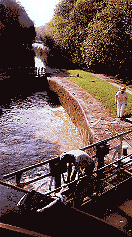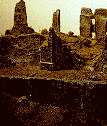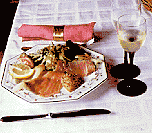Locking Through on the
Canal du Midi in Southern France
By Pat Middleton ©
"I should
tell you
that a recent trip to the Canal du Midi in Southern France was an assignment meant to
scout out the celebrated canal for river buffs back in the Midwest. Or to share with
readers impressions gleaned when trading a steamboat cruise on the Great River for a
15-meter barge and a 2-meter deep canal, where we floated for seven days under a
sun-dappled canopy of mature sycamore trees.
But truly, this story dates back nearly 25 years to when I declined
an invitation to co-manage the Mark Twain, a highly polished peniche or hotel barge
on the canals of France. I had no idea, then, how aptly named my floating home would prove
to be when, in mid-life, I authored four guides to traveling the Mississippi River Valley.
But then, if I had taken the position, I might not have discovered the Mississippi."
~ Pat Middleton
For further information on
cruising with the ROSA, please contact Rosa-Croisieres, directly:
ROSA-CROISIERES
47 avenue Caldéron
31600 Muret
France
Tel : + 011-33 5 61 51 03 59
Fax : + 011-33 5 61 51 75 00
EMAIL: : r.croisieres@confluent.fr
For more information on the Canal itself, see the Booklist on the ROSA-CROISIERES web site!
Faxing Europe, by the way, is an easy and inexpensive way to communicate with hotels and tourism agencies that are not yet online!
IF YOU GO:
Toulouse is well served by both airplane (just minutes from the Blagnac Airport) and Train, including the fast TGV. The Train Station (Gare) is located right near the harbor for the ROSA.
Taxi to the central city
is about $20.
Where to Stay:
Hotel de Brienne
20 Blvd Marechal Leclerc
– 31000 TOULOUSE,
Tel:
011-33 5 61 23 60 60 or
FAX:
011-33 5 61 23 18 94
Comfortable, reasonably priced traditional hotel within comfortable walking distance of
the Canal de Brienne, the Garonne River, and the Capitol, Centre Ville. 2 people about $80
a night, excellent breakfast about $8 each.

The IBIS Toulouse Aeroport Hotel
80 Avenue du Parc – 31700 Blagnac France
Tel:
011-33 5 61 30 01 00 or
FAX:
011-335 61 30 02 83
Just minutes from the Blagnac Airport. About
$70 per night for 3. Restaurant Dinner for 3 was also about $70.
For information on houseboat rentals and other canal options,
contact the French Agent at Ad'Navis
La Maison du Canal
8 rue des Peniches
34500 BEZIERS, France.
Telephone 011-334-67-62-18-18 or
FAX 011-334-67-35-05-12.
For more information on the Midi-Pyrenees,
email
swfrance@aol.com
Chart of a small section of canal.
The Canal du Midi is a man-made waterway stretching eastward 149 miles from Toulouse to Sete on the Mediterranean Sea. From Toulouse to the west, a series of rivers and connecting canals provide access to the Atlantic Ocean near Bordeaux. When built between 1667 and 1681, the Canal provided a route safe from the dangers of sea navigation, the Gibraltar straits and pirates and was considered to be the "Marvel of Europe."
Peacefully serene, the canal meanders through rich fields of wheat and vineyards, along
the ancient road to Rome. Its shoreline is marked by the march of sycamores waving
flag-like against the blue skies. For hundreds of years, horses plodded the heavily shaded
towpaths, pulling wooden barges filled with lumber, coal, grain, spice, wine or thatching.
Today, all of the horses and most of the barges have disappeared, but 50,000 sycamores
still shade the towpath now used by bicyclists and hikers, and the occasional pilgrim
following the path of St. Jacques de Compestella to Spain.
Our plan for the cruise was to fly into Toulouse (via Chicago and Milan) and spend two nights at the Hotel de Brienne, just off the Canal de Brienne (connecting the Garonne River with the Canal du Midi) and within walking distance of the medieval city center. There we would eventually rendezvous with staff from the ROSA for the short drive to the Canal du Midi, just outside the former city walls.
A guided tour of the old city, proved
invaluable in providing historical background to help us appreciate all that we saw along
the cruise. History is an important aspect of travel in France. 11th and 12th
century goings-on are considered to be "old, but not THAT old." Churches,
bastides ("modern" medieval planned villages), the sieges imposed by armies from
the north and the terrors of the Inquisition were visible everywhere about us during our
cruise. If Toulouse today has 100,000 university students, it is because Catholic teaching
friars (Dominicans, Carmelites, Franciscans, and Augustins) gathered here in the 13th
 century to debate the
Cathar heretics. To qualify as "really old" one must consider the fine golden
jewelry left behind by the Celts or the early Gallo-Roman ruins.
century to debate the
Cathar heretics. To qualify as "really old" one must consider the fine golden
jewelry left behind by the Celts or the early Gallo-Roman ruins.
Our vessel, the 15-meter long ROSA, was a working canal barge in the early days
of the century. Today, her wood panels polished to a glossy sheen, her paint bright, she
carried mostly American passengers, as many as eight in four air-conditioned staterooms. On this cruise, we were six, including two couples from
Chicago, and our French crew of Bernard (our superb Chef), Michel (pilot) and Sandrine
(hostess).,
air-conditioned staterooms. On this cruise, we were six, including two couples from
Chicago, and our French crew of Bernard (our superb Chef), Michel (pilot) and Sandrine
(hostess).,
The historic peniche attracted a crowd of onlookers along our route, as do the steamboats on American rivers. Every low slung stone bridge and each of the locks had a small contingent of good-natured observers. While the barges, towed by horses until the early 1930s, had once passed the lock houses every half-hour, they were rare today on this portion of the river and greeted with enthusiasm by the locals.
"Come back and get a picture with the peniche behind me," a fisherman called out urgently after I had passed him on my bike. The message was relayed up the towpath by bikers behind, and I had to scurry to get into position in time to catch the shot. It was the best photo of the whole cruise.
"Que vous etes arrivez!" one of the observers called out at the lock.
"You have certainly arrived!" And indeed, we felt that we had. 
"Eighteen locks, tomorrow, folks," Bernard told us, "including a quadruple just as we leave the Basin at Castelnaudary." We were lingering, as we did every evening, over a two-hour dinner (Stuffed artichoke, fois gras, cassoulet, moules, escargot, smoked salmon) and luscious dessert while Bernard gave us the briefing for the next day’s activities.
The Canal du Midi, he explained, is a rare "summit canal" which means that it
has two slopes which boats must climb and descend between Toulouse and Sete on the
Mediterreanean Sea. Climbing the peak by boat in the late 17th century
sometimes required a series of as many as
three or four locks, one right after the other. There are 63 locks between Toulouse and
the sea.
Locking through the unique egg-shaped locks of the Canal provided an endlessly entertaining dance between Bernard (acting as first mate), Michel and the ‘eclusier’ or lockmaster. Michel eased the five-meter wide peniche into the six-meter wide lock. Hand-wind the right gate closed behind the boat, hand-wind the left gate. Bernard manned the lines, watching that the bow didn’t hang up on the gate. Then open the left and right sluices to raise or lower the water in the lock to the next level—hand-wound, of course! Adjust the lines on the ROSA’s chubby cleats as the boat rises or descends with the water. Finally, open the two front gates, by hand, and ease the vessel out into the new pool of the Canal.
If the lock is a double, a triple or quadruple, the dance is repeated over and over again. It was only at the quadruple lock at Saint-Roch that we saw the first sign of a truly modern invention, electric motors being applied to the gates! West of Toulouse an innovative water-slide carries the entire lock down a steep incline, replacing eight of the original locks!
"It’s hard work doing the locks," one 50ish woman claimed as
she braced to hold her houseboat steady amidst the turbulence of white water pouring
through the sluices. "Especially when there are ten or more a day!"
Rental boats are 2-3 meters wide, about 8 meters long and sleep 6-10 people. The canal is easy enough for a beginner to navigate (except on the 18-lock day!) and we saw many multi-generation family groups cruising in rental boats. Canal charts plot the location of the locks, harbors, etc.
Personal and rental houseboats were pleasantly infrequent during our late May cruise. Peak season for cruising is July and August, and Bernard chooses then to travel the canals between Toulouse and Bordeaux in hopes of avoiding long waits at the locks.
We passengers agreed that the most challenging decisions of the whole week occurred at the locks—for then we would decide whether the distance to the next ‘ecluse’ or lock and the time of day suggested that one walk or bike or lounge on deck to the next lock.
Would we miss the aperitif if we biked? Was it a comfortable distance for a walk? For
the most part, the focus of the cruise was the exquisite French cuisine, the complimentary
regional wines, and the constant panorama of scenery unfolding beyond the
sycamores—wheat fields and vineyards dotted with centuries-old villages and
farms.
The Canal itself is a sun-dappled wonder, built 300 years ago thanks to a unique
partnership between Louis 14th and entrepreneur Pierre Paul Riquet. Riquet
himself was not an engineer but a wealthy salt tax collector. He astonished the world one
day by declaring after a hike on the Black Mountain that by collecting water from the
mountain streams into a huge basin, he could provide water for a canal system that would
allow barges to climb and descend the 600-foot high Naurouze Sill. Augustus, Charlemagne,
Francis and Henri IV had all tried and failed to accomplish the same project with its
three-fold challenge: finding enough water to fill the canal, the irregularity of rivers
like the Aude which crossed the canal, and the height of the Sill. 
St. Fereol Basin, above Avignonet-Lauragais, holds 6 million cubic meters of water and its shimmering 67 hectares of surface area, when built, was the largest reservoir in the world. Riquet hired 1,000 men to start work on St. Fereol Basin. Eventually, 12,000 workers dug and built the entire canal and lock system by the strength of their arms. From Sete to Toulouse, Riquet worked on the entire canal at once; boring through solid rock, constructing canal bridges (where the canal passes over capricious rivers), installing multiple locks to carry a boat through especially steep areas. The determined Riquet solved one problem after another. For 15 years, innovated concepts like paid holidays, Sundays off, rain days, and sick days helped to keep his loyal workers on the job.
When he died exhausted and near financial ruin in 1680, only 4 km of canal were still unfinished. His sons completed the "Marvel of Europe" in 1681. It was an immediate financial success and Louis 14th declared it a "great work of peace." Today, at the Naurouze Sill, a leaf carried by water from the St. Fereol Basin’s feeder canal seems to hesitate just momentarily before slipping randomly either toward Toulouse or Carcasonne and the Mediterranean Sea.
"Is my English clear enough?" Bernard asked me as we toured St. Fereol basin. "Do the others understand well enough what I am saying about this basin and the Canal? It is such a wonder!"
In 1996 the Canal was declared a UNESCO World Heritage Site, a title shared with other monuments to human culture, including the Cahokia Mounds just east of St. Louis, the Alhambra of Granada, and the Taj Mahal in India. And in 1999 I made up for the missed adventure of my youth by traveling, at last, with the ROSA on the Canal du Midi.
| CREDIT: Pat Middleton is author
of the Mississippi River travel series, DISCOVER! AMERICA’s GREAT RIVER ROAD,
available from Heritage Press, Rt. 1, Stoddard, WI 54658. 888-255-7726. She is also founder of http://www.greatriver.com, The largest and most comprehensive Mississippi River travel site on the Internet. Visit http://greatriver.com/waterwaycruises/ for additional resources for planning a trip on the French waterways. |
| Advertise YOUR Business Here 888-255-7726 or Email: ads@greatriver.com |
| Coming Soon! For More on Waterway
Cruises in Europe. . . Exploring the French Camargue region at the mouth of the Rhone. Steamboating on the Rhone River delta and Lac Leman in Switzerland. Colorful Provence Fly-fishing, paddling, and cruising in Glacier National Park! |
Feedback! Please let me know if you find our waterway cruise reports helpful!
Photo Album | More on S France | Waterway Cruise Review |
[ Return to Mississippi River Home Page ] [Sign
Guestbook ]
[ Travel Insight Features ] [ River Guides & Charts ] [ Search greatriver.com ]
[Advertising Info
] [ Become a
Subscriber! ]
 Contact
us! Heritage Press/Internet Publishing, Rt. 1, Stoddard, WI 54658-99801. Phone
608-457-2734 or email Heritage@greatriver.com
Advertising on greatriver.com puts your business in front of 1400 readers EACH DAY.
Contact
us! Heritage Press/Internet Publishing, Rt. 1, Stoddard, WI 54658-99801. Phone
608-457-2734 or email Heritage@greatriver.com
Advertising on greatriver.com puts your business in front of 1400 readers EACH DAY.
© All content and photos are copyrighted by Heritage Press or the owners and may not be
used in any way without permission of the publisher. Web page design © 1997 by Heritage Internet Publishing. Rt. 1,
Stoddard, WI 54658. Phone 608-457-2734 or Fax 608-782-5768.